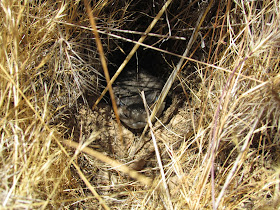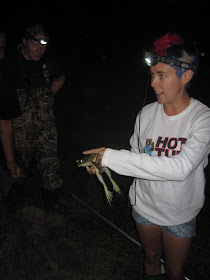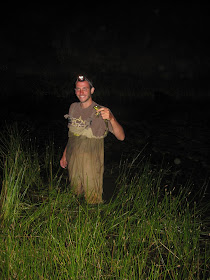Fear is a common word and feeling associated with snakes.
Ophidiophobia is one of the most shared fears of people worldwide. Although
this post will not discuss the many proposed hypotheses for people’s fear of
snakes, it will cover how fear can influence ecosystem processes. This post
will mainly focus on rattlesnakes as predators – all statistics/facts I report
are based on studies of North American rattlesnake populations.
Most people are afraid of snakes because of their nasty
reputation which is propagated by the popular media. Snakes are deemed
aggressive killers, and although many studies have demonstrated the docility of
snake temperament, they are in fact killers. However, snakes are not killers of
humans (less than 0.001% of all snake bites in the U.S. result in death),
but killers of their small mammal prey. This makes our fear of snakes
irrational, but small mammals have much to fear. This fear dictates how small
mammals live their lives, often impacting whole ecosystems.

When predators chase and kill their prey they exert consumptive effects on the prey population
When people think of predators, they usually think of a
predator chasing down and eating its prey. Direct killing events are important in
maintaining prey population numbers, but a predator’s consumptive effects (those
due to the direct killing and consumption of prey) on the ecosystem are usually
nothing compared to its non-consumptive effects (those that do not result in the
direct death of prey). For instance, a lioness can chase and take down one wildebeest, but the stampede of the wildebeest herd created by this chase may kill
other wildebeest and other species (remember the Lion King stampede?), destroy
vegetation, and induce a stress response in all animals involved that will
persist long after the initial predation event.
Involvement in a life-threatening predatory attack has been
shown to enable rapid and enduring learning in prey species, to induce physiological stress
significant enough to impair the day-to-day activities of prey, and to
drastically affect the functioning of food chains in the ecosystem. Such
non-consumptive predatory effects are collectively called the Ecology of Fear. Here, I will discuss
how the stress responses of prey to their predators affect many aspects of
their lives, and how rattlesnakes can be used as model predators to study stress
in wild small mammal populations.
First, let’s define what a stressor is. A
stressor is any stimulus that either directly threatens an animal’s survival or
is perceived to do so. Fear-induced stress is psychological and occurs when a
stimulus is perceived by an animal as threatening through evaluation by the
cognitive regions of the brain. Cues that indicate predator presence can invoke
fear-induced stress.
The stress response pathway starts in the brain at the hypothalamus which releases CRH (corticotropin-releasing hormone) into the pituitary. This stimulates the pituitary to release ACTH (adrenocorticotropic hormone) into the blood stream. ACTH stimulates the adrenal glands to produce stress hormones (corticosteroids). Corticosteroids create the physiological responses we feel to stress and influence our behaviors. The is normally called the HPA-axis.
We also must keep in mind that not all stress
is bad. In fact, the stress response pathway evolved to
help animals cope with fluctuations in their environment. Most people believe
that stress starts to have negative health effects only when it persists for too
long. However, whether prolonged exposure to predators causes long-term
negative impacts on prey populations is still debatable. It is proposed that
although the stress response of prey to predators alters the prey’s immediate health,
the long-term response is adaptive.
When exposed to predators, prey alter their
day-to-day activities. For example, they may forgo feeding in food patches
where they usually consume high energy food, and instead feed in low energy
food patches. Predator presence not only limits where prey can feed, but can also
cause fear-induced stress that increases prey metabolic rate (breathing rate)
which accelerates the rate at which prey use energy. So prey burn a lot of
energy, but cannot access the food to replace this lost energy because they are
afraid of predators. If this cycle persists long enough, prey body condition can
drastically decrease and could result in death by starvation.
Prey may also forgo mating or have lower
reproductive success when predators are perceived to be present. Several
studies have shown that females of different species of animals exhibit lower birth
rates or litter sizes when in a state of fear-induced stress. Forgoing mating
is considered adaptive if it is better for prey to wait to have babies after
the amount of predators in the area has declined. This is called predator-induced breeding suppression.
Older yellow-belled marmot mothers that exhibit high levels of stress hormones produce significantly smaller litters than mothers with low levels of stress hormones (as seen by the graph). Taken from Monclus et al. (2011).
I have just mentioned only two of a myriad of
ways that predators affect prey other than direct consumption. The non-lethal
effects of predators make up a major field of research right now, and studies
on these effects have been influential in understanding stress-related diseases
in humans, like PTSD (post traumatic stress disorder). However, there are several problems with many of these predator-prey
studies. First, most studies are conducted in a controlled laboratory environment
and as several papers have pointed out, results found in the lab don’t always
translate well to wild animal populations. Second, the few studies on wild
animal populations that do exist do not actually know the exact locations of their
predators, or how predators behave in response to their prey. An index of
predator density is usually estimated through monitoring surveys (traps and
wildlife cameras), and this index is correlated to the stress levels of wild
prey populations. Wild prey responses to actual predators are almost never examined. Studies that use rattlesnakes as model predators may provide answers
on whether prey exhibit fear-induced stress when actively confronting a real
predator.
Why are rattlesnakes model predators for predator-prey studies? Let me tell you.
- These snakes are large-bodied and amenable to implantation of radio transmitters. Radio transmitters emit a radio wave that can be picked up by a receiver, allowing researchers to track the exact location of individual snakes. Thus, we can know where snakes implanted with transmitters are at all times.
- Rattlesnakes are sit-and-wait ambush hunters that remain at a hunting site for hours to days waiting for unsuspecting prey to pass them by. This is great because once we know where a snake is, we know it’s going to be there for a while. We can monitor a snake’s location and see how prey respond to it. Since rattlesnakes have low endurance and do not chase their prey, their prey are also more willing to inspect them.
- Rattlesnakes are not easily disturbed by human observers, usually relying on camouflage to blend into their surroundings. Thus, researchers including myself have figured out that one can easily set up fixed video cameras overlooking snakes to record when they interact with prey.
- Researchers can easily restrain rattlesnakes in the field when they want to present a live predator to specific individuals of wild prey. Most studies are only able to use predator cues such a scent, or models/replicas of predators to elicit prey responses.
Photos of the typical ambush posture of hunting rattlesnakes (which consists of a tightly coiled body), and the wireless network security cameras we use to record natural rattlesnake behaviors.
Because of the abovementioned qualities of
rattlesnakes, we can use them to more easily study fear-induced stress in wild prey. For
instance, we can present a restrained rattlesnake to focal prey individuals, and examine how long each individual's stress response persists after discovering the snake. If prey experience prolonged stress after encountering a snake, they may reduce time spent on other important activities such as feeding or mating,
as mentioned previously. This could have ecosystem level consequences. For example, ground squirrels create burrow systems that are widely used by many different animals in their ecosystem. If squirrels are greatly concerned with avoiding snake predators, they may reduce time spent on burrow construction, limiting the amount of available burrows to others in the area. We are currently conducting these types of studies on wild ground squirrel populations in California.
As in previous studies, we can examine how
the density of rattlesnakes in an area affects their prey’s stress response.
Most studies have examined how mammalian or avian predators affect prey populations. An important distinction between these two predators
and rattlesnakes is that rattlesnakes are ectothermic, or ‘cold-blooded’, while
mammals and birds are endothermic, or ‘warm-blooded’. Cold-blooded animals are often found at much higher densities in an ecosystem than warm-blooded animals. Because rattlesnakes occur at higher densities than large mammalian carnivores, their effects on shared prey are likely different. For instance, theory suggests that prey should not mount strong defensive responses to predators when they encounter predators too often. Thus, prey may not respond to rattlesnake populations as strongly as mammalian carnivore populations.
Finally, rattlesnakes also
exhibit distinct activity seasons as a consequence of being ‘cold-blooded’.
When the climate becomes either too hot or too cold they ‘hunker down’ in a
refuge, patiently waiting for the bad weather to pass. Their prey may
acknowledge times when snakes are inactive and exhibit changes in their activities and stress
response pathway. For instance, prey may take advantage of cold days (when snakes are incapable of a lot of activity) by feeding/mating more. An increase in prey behaviors may be correlated with changes in stress hormone levels.
The Ecology of Fear is an exciting field of research from which we can not only learn a lot about wild animal responses to predators, but also our own responses to traumatic events. Few studies have examined the fear-induced effects of snake predation even though rattlesnakes are model predators for such studies. I hope that my research along with research from others will advance our knowledge on this topic.
-----
This post was inspired by a special feature on the ecology of stress in the journal, Functional Ecology, published this year. I took several of my examples from two particular papers in this special feature and am grateful for these authors' review of the literature:
Other resources used in this post:
-----
This post is also a part of the first herpetology blog carnival organized by a network of students,
naturalists, and professionals whose goal is to use social media to communicate information
about amphibian and reptile natural history, science, and conservation. Our inaugural event is inspired by the Year of the Snake, and so we are writing blog posts about the diversity of ecosystem services
provided by snakes. We encourage
everyone to follow us on Twitter using #SnakesAtYourService. We hope this social media
event will be the first of many that touch on different themes related to the
importance of amphibians and reptiles.
'Snakes At Your Service' participating blogs and authors:
Life is Short
But Snakes are Long: Ecology of Snake Sheds by Andrew Durso @am_durso
Nature Afield: Pythons as Model Organisms by Heidi Smith @HeidiKayDeidl
Ophidiophilia:
Converting Ophidiophobes to Ophidiophiles, One Kid at a Time by Emily Taylor @snakeymama
The Traveling
Taxonomist: Snakes of Madagascar: Cultural and Ecological Roles by Mark
Scherz @MarkScherz
SnakeBytesTV: The Brown Tree Snake of Guam by Brian Barczyk @SnakeBytesTV
Social Snakes: Good Neighbors Make a Greater Impact: How Viper Behavior Increases Their Effect on Prey Populations by Melissa Amarello @SocialSnakes
Strike,
Rattle, & Roll: Snakes and the Ecology of Fear by Bree Putman @breeput
Australian
Museum: When the Frogs Go, the Snakes Follow by Jodi Rowley @jodirowley














































